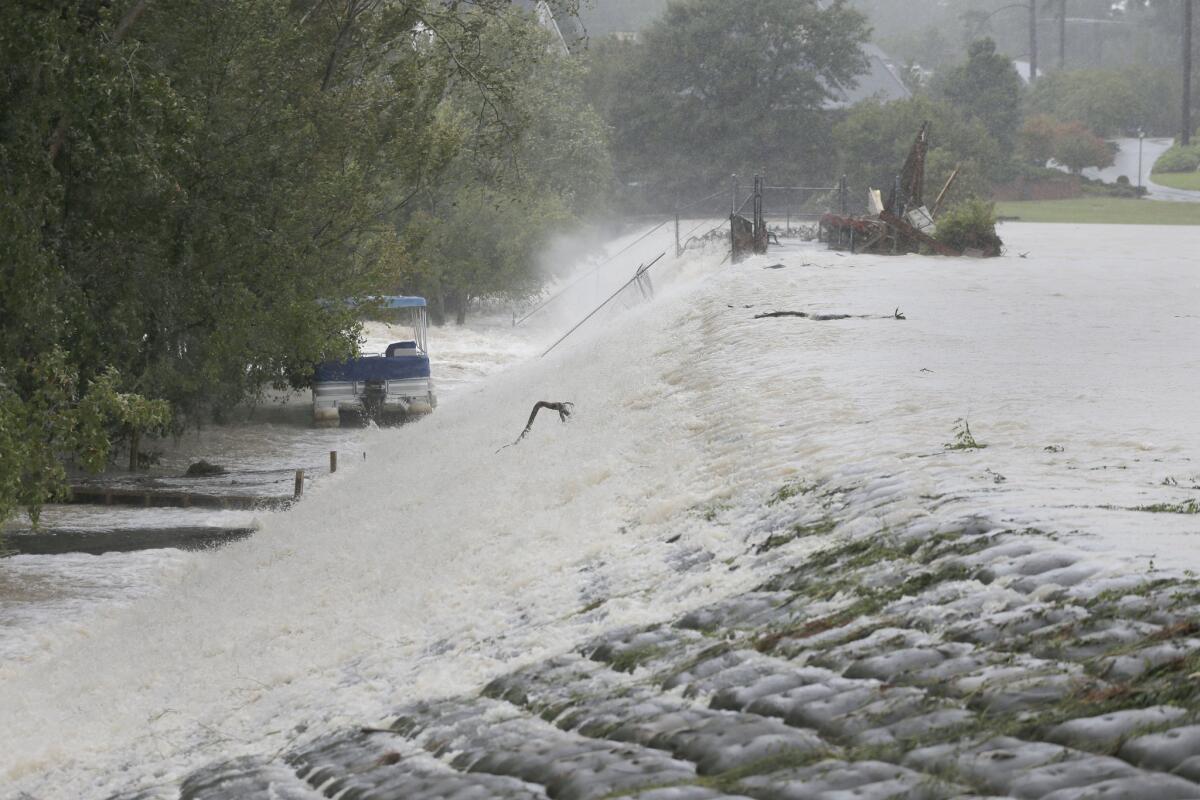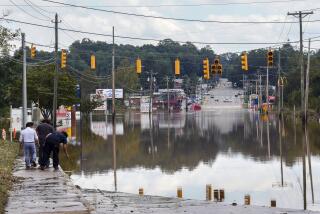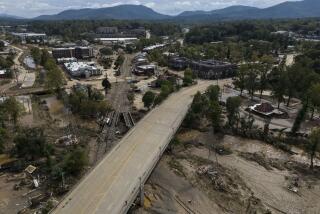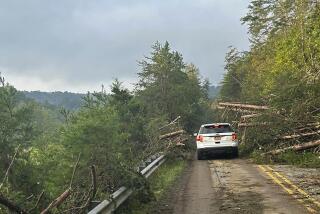South Carolina residents rush to higher ground as 14 dams fail

Floodwaters rush over a dam on Forest Lake in Columbia, S.C., on Oct. 4, 2015.
Reporting from Columbia, S.C. — Days after a record torrent of rain flooded parts of South Carolina, Cedric Williams found himself once again watching water flow like a river through his frontyard. For the second time in two days, he rushed to pack up his family’s belongings.
“It’s heart wrenching — I never imagined a flood like this here, in the middle of the state,” said Williams, 34, an elementary school teacher, who sought shelter Wednesday at a high school east of Columbia, after a release from nearby Beaver Creek Dam. “The sheriff just warned me that if the house isn’t fully flooded yet, it soon will be.”
Early Wednesday, officials had urged residents near Beaver Creek Dam to immediately seek shelter and move to higher ground.
NEWSLETTER: Get the day’s top headlines from Times Editor Davan Maharaj >>
A few hours later, Richland County Sheriff Leon Lott said the situation had been stabilized and residents were allowed to return home. But the flood emergency throughout many parts of the state is not over.
With 14 dam failures statewide and 62 more in danger of failing after historic rains pushed capacity beyond limits, much attention has turned to dam safety.
Most of the water damage in the Midlands has taken place along the Gills Creek watershed, a 70-mile-long network of streams, ponds and lakes that weaves through the cities of Columbia, Forest Acres and Arcadia Lakes, as well as the U.S. Army’s Ft. Jackson.
Beginning in the early 1900s, many small earthen dams were built mainly by landowners along the network to create recreational lakes. Through the decades, neighborhoods have been developed around the scenic lakes, creating storm water runoff problems, according to the Gills Creek Watershed Assn.
Throughout much of the forested lands of South Carolina, there are more than 2,400 state-regulated dams, most of which are earthen dams on private property. Of those, 180 are deemed high-hazard potential, said Mark Ogden, project manager with the Assn. of State Dam Safety Officials, a nonprofit organization.
When unprecedented rain struck over the weekend — with Hurricane Joaquin-fueled storms dropping as much as 20 inches of water in some areas — many of the dams were strained beyond capacity.
Some experts said Wednesday that more rigorous dam inspection and oversight would have eased the flood danger. Going forward, residents need to be better prepared to evacuate in severe weather, officials need to move quicker to decide whether controlled water releases are needed to prevent breaches and dams need to be more rigorously monitored, said James H. Knapp, a professor of Earth and Ocean Sciences at the University of South Carolina.
“The failure of dams has been the major part of the issues on this side of town,” said Knapp, who lives in an area adjacent to Gills Creek, where many upscale homes were submerged. “This has taken most people completely by surprise - there just wasn’t a full appreciation of the vulnerability of these dams before this rain.”
Knapp said he did not understand why people living downstream of the dams had not been warned of potential breaches in advance of the heavy rainfall.
South Carolina is behind other states across the country when it comes to dam safety, Ogden said. In 2014, the state reported performing only 63% of its scheduled inspections for the 180 high hazard dams.
“There are certainly areas that South Carolina could improve or take a look at what they could do,” Ogden said. “The state is scheduled to inspect dams at least once every two years. You would expect 100% compliance for high hazard potential dams, but they have fallen far short of that. These are good people doing the best job they can, but they could use additional resources.”
At a news conference, however, South Carolina Gov. Nikki Haley pushed back against criticism that the state had not done enough to prepare dams before the storms.
“One dam failure is too many, but in a situation like this we are extremely grateful for where we are today,” Haley said, praising emergency responders for working throughout the night to mitigate the damage. “This is a thousand year flood and we have thousands of dams in our state … 62 we are watching and 13 have failed. When we have floods of this magnitude, it’s really amazing that we have not had more.”
Noting that the danger was still not over, with potential evacuations in seven more counties as the rain trickled down to lower parts of the state, Haley added: “There’s plenty of time to analyze this after.”
ALSO:
Here’s how bad the South Carolina floods are
Heavy rain and flooding stun South Carolina; at least 12 people killed
Volunteers turn out in force to supply South Carolina with drinking water and food
More to Read
Sign up for Essential California
The most important California stories and recommendations in your inbox every morning.
You may occasionally receive promotional content from the Los Angeles Times.











